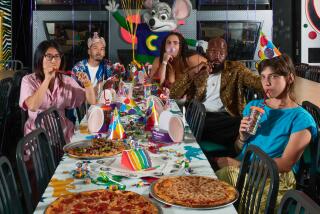The Class of 2000 Charts Its Course : Teenagers: Y2K graduates inherit an era of prosperity but also alienation. Family ties remain crucial.
- Share via
The Cold War was over before they were 10. They think the stock market goes nowhere but up. They know all about sex, but also about AIDS. Their schools have computers in the classroom but metal detectors by the front door. They wear studs in their tongues and pagers on their belts.
They are the Class of 2000, more than 3 million young Americans now starting their senior year in high school, and like every generation of teens, they dare their parents to understand them.
But more than parents are watching these Y2K youth. Apart from their symbolic status as standard-bearers into the next millennium, they form the leading edge of a teen population bulge that will surpass even the baby boom at its peak.
Courted by advertisers, fretted over by politicians, the Class of 2000 inherits an era of prosperity but also one of alienation, as families grow more fractured and strange new perils surface with each day’s news.
“We’re out here alone as a generation,” says Kim Blair, a senior at Columbine High in Littleton, Colo. One day last April, she watched her safe, suburban school become a killing ground, and she realized her class would have to learn how to take care of itself.
“In my parents’ generation, they didn’t have a lot of teen violence or gang problems,” Blair says. “They didn’t have the Y2K bug; they barely had computers. I think it’s hard for parents to keep up with the kids. We’re learning so many things so much quicker than they are.”
Nostalgia for the Cold War
By many social measures, the Class of 2000 differs little from any other teen generation deemed by society to be headed to hell in a handbasket--which is to say every generation in recent memory, from pot-smoking ‘60s hippies (now hand-wringing parents themselves) to slacker Gen Xers (now running their own Internet companies).
Some comfort can be found in recent statistics:
Teenage smoking and illegal drug use climbed during most of the ‘90s but appear to have stabilized or dropped slightly in the last few years. The teen pregnancy rate has dropped 17% since 1990. The teen abortion rate has fallen 31% since 1986. Violent crime committed by teens has dropped steadily since 1993.
Beyond the numbers, however, there’s a troubling sense that the Class of 2000 is coming of age in a harsher, more confusing era.
A modern teen, it has been estimated, is exposed to more information in a single day than a medieval peasant was in a lifetime. But the flood of data hardly equals wisdom, which today’s youth will need in balancing the curses and blessings of their high-tech future.
The easy exchange of personal information over the Internet carries the threat of a world without privacy. Genetic engineering, whether of plants, sheep or human embryos, poses ethical quandaries that can only grow more acute as the Class of 2000 matures.
The uncertainties are enough to make Keith Poertner, 17, sound almost nostalgic for the Cold War, when two superpowers stared each other down with the mutual threat of nuclear annihilation.
“Now all the small countries have nukes, and just anybody can push the button,” says Poertner, of Traverse City, Mich. “And you’ve got terrorists and germ warfare and everything. You never know where the threat’s going to come from.”
Today’s teens are freer than ever to follow their own paths, beyond the reach of parents. In the ‘60s, when music came on black vinyl disks instead of silvery plastic CDs, baby boomers forged a generational identity with loud and annoying rock ‘n’ roll. Today’s youth, by contrast, listen to all sorts of loud and annoying music: rap, reggae, hip-hop, punk, techno.
Even high-school cliques are more splintered. Jocks, nerds and preps still roam the corridors, but so do punks, Goths, skaters, stoners and gangstas.
It’s hard for terrified parents to swallow the argument that Marilyn Manson’s profane and violent lyrics are merely this generation’s version of Elvis Presley’s gyrating hips. But it’s equally hard for youths to accept the suggestion that they can be corrupted by a pop song or video game.
Frank Bitetto, 17, a punk-rock drummer with a partially shaved head, enjoys standing out from the crowd, but he says that hardly makes him a menace.
“I’m sure if I went out and shot somebody right now it would probably make the news that I listen to Marilyn Manson and Nine Inch Nails. But it wouldn’t make the news that I have Aerosmith albums,” says Bitetto, who also works at Wal-Mart and serves as president of his high school drama club in Franklin, N.H.
The Class of 2000 is more racially diverse than any before it. Thirty-three percent of U.S. teens belong to minorities, compared to 28% of Americans of all ages. By the time these kids retire--if such a thing is still allowed in the mid-21st century--minorities will nearly add up to a majority of the U.S. population.
Teens increasingly face cultural conflicts, sometimes within their own household.
Kauxiong Yang, a Hmong refugee from Laos, lives in the Minneapolis suburb of Brooklyn Park. She flips through Vogue and Glamour magazines, listens to pop stars Jewel and Alanis Morrisette, and wears Gap jeans with the seams torn just so at the bottom.
She also happens, at 17, to be married--common in Hmong culture but odd enough here that she initially kept it a secret from classmates after moving last year from California. She lives with her 22-year-old husband and his family, who expect her to be obedient and industrious. She yearns to be a typical American teen.
“I keep lying to myself to a point where I don’t even know who I am,” Yang says. “The minute I step into the house, I’m pretending to be someone I’m not.”
Teenage ‘Cool’ Equals Big Profits
Corporate America has tuned in to the Class of 2000, which is riding the front of an unprecedented teenage wave. The 12-to-19 age bracket has increased each year since 1992 and is expected to reach 35 million by 2010, an “echo boom” larger than the baby boom at its peak.
“They’re spending a huge amount of money,” says Michael Wood, vice president of Teenage Research Unlimited, a Chicago-based market research firm. He estimates last year’s teen purchases at $141 billion, up 16% over 1997.
Unlike their parents, who rebelled against corporate America, the children proudly wear its advertising. At the moment, the “coolest” brands among teens are Nike, Adidas, Tommy Hilfiger, Sony and Nintendo, according to surveys done by Wood’s firm.
“Cool” can equal big profits. Puff Daddy isn’t just a rap musician. He’s also a producer and entertainment company CEO, he’s in publishing and fashion, and he made the cover of Forbes magazine for his $53 million in earnings last year.
Ask teens what it takes to be considered cool, “and the No. 1 and 2 answers have always been good looks and being funny,” Wood says.
But he notes one big change: “Teens today say it’s very difficult to be rebellious, because pretty much everything has been done.”
If mass marketers know how to bend a generation’s attitudes and behavior, social engineers are catching on as well. Researchers credit renewed education efforts-- more nuanced than the “Just Say No” campaigns of the ‘80s--for the recent halt in the rise of teen smoking and drug abuse.
Education can even have a tempering effect on hormones. Awareness of AIDS and more knowledge about contraceptives have helped reduce the teen pregnancy rate. By graduation, about 60% of the Class of 2000 will have had sexual intercourse, a rate that researchers say appears to be declining, partly due to sex education encouraging abstinence. In some circles, virginity is cool.
“I think [sex] belongs inside marriage,” says Jason Hartbarger, 17, a home-schooled senior in Cary, N.C., who has had a girlfriend for nearly two years. “It’s not something that I have any interest in. I think there are other ways to be serious in a relationship and to make things last.”
While sex and drugs may worry parents, many teens bridle at what they consider adult misconceptions.
“There are a lot of us out here who have get-up-and-go, who want to accomplish things,” says Brad Lambrecht, 17, of Lisbon, N.D.
He plans to leave the family farm to pursue a career in music, making him one of many in the Class of 2000 with a clear vision for the future:
* In New York City, Lakecia Benjamin, 16, practices up to four hours a day on her alto saxophone, playing gospel, jazz and funk at the Fiorello H. LaGuardia High School of Music & Art and Performing Arts. Her cheeks puff up until her dimples vanish, and she looks off to the side, ecstatic and absorbed, as mellow notes dance in the air. “I practice forever, just to get that one sound,” she says.
* A baseball diamond defines the universe of Jim Olds, 17, in Lafayette, Ind. Muscular and confident, he dreams of playing professional ball and fills his life with the game, rhapsodizing about the intensity of the face-off between batter and pitcher: “You just look him in the eye and you compete. He does his best, and whoever comes out on top comes out on top. I suppose the best thing about baseball is there’s always tomorrow.”
* At the private Menlo School in the Silicon Valley town of Atherton, Chris Niederauer, 17, has his own Web site (www.ccntech.com), 15 e-mail addresses and two powerful computers. Skinny and pale, with soft hands and blue eyes, he’d be happier if he could spend more than his usual 45 hours a week on the computer. “Nerds around here, we don’t have a bad reputation,” Neiderauer says. “Lots of the jocks are trying to learn programming, so they turn to us for help.”
One might expect a healthy geek factor in Silicon Valley, but high technology has transformed the Class of 2000 nationwide.
In Gallup, N.M., Navajo student Aaron LeMaster tinkers with his computer and builds gadgets using parts from old VCRs. He dreams of starting his own electronics company, and his mother, awed by her son’s technical knowledge, doesn’t doubt his potential.
“He learned it all on his own, just by taking things apart,” says Lenora LeMaster. “He’s very self-driven.”
American Dream Still Glimmers
About two-thirds of the Class of 2000 will attend college next fall. Their economic outlook is excellent, with the playing field more level than ever for young women, who now outnumber males in college enrollment.
But the outlook is darker for those who don’t pursue higher education, and darker still for the 4% of high schoolers who drop out before graduation. Experts predict a widening gulf between haves and have-nots in America’s increasingly information-based economy.
Poertner, in Traverse City, hopes to graduate next spring but admits that his record of cutting classes means he’ll have to “work my patootie off.” His mom is a housewife. His dad is a diesel mechanic who digs graves for extra money. Lanky, goateed Poertner hasn’t made any plans for himself.
“They say by the end of next year I’m supposed to decide what the heck I’m supposed to do with the rest of my life,” he says. “Well, I just don’t care to. Nothing’s really popped up in my face.”
For others, even those with few advantages, the American Dream still glimmers.
Oswaldo Mendoza, 17, born in Mexico City, now lives with his family in Reno, Nev. He works after school as a busboy at a casino, saving his minimum-wage pay for college. “That’s why we came to the United States--to get a better way of life for me and my brother and sister,” he says.
Angela Ford attends a Chattanooga, Tenn., school founded in 1865 to educate former slaves. Most students live in nearby public housing. Administrators battle poor attendance and a high dropout rate with inspirational posters about “Great Expectations.”
Ford takes those posters to heart. A striking young woman with almond eyes, she has never met her father but says she doesn’t feel deprived, nurtured instead by her mother, grandmother and aunts. With a near-perfect 3.95 GPA, she plans to pursue college degrees in electrical engineering and business.
“I feel like I can do this,” Ford says. “My mother gave me a lot of educational guidance. She made it fun. She said hard work would pay off later.”
Parents ‘Check Out’ of Teens’ Lives
The headlines often serve up polarized views of the Class of 2000, casting its members either as savvy denizens of the dot.com decade or as victims adrift in a cultural sea of sex and violence.
Spend time with these teens, however, and you discover a new generation with old-fashioned concerns: friends, romance, money and, above all, family.
“All teenagers need at least one adult in their life who really cares about them,” says Laurence Steinberg, a psychology professor at Temple University and author of “You and Your Adolescent.”
Yet the traditional family is becoming less common, with 28% of children under 18 now living with just one parent, according to census figures.
Not that having both parents under the same roof guarantees good parenting. Steinberg says studies suggest that about 30% of parents, from drug-addicted dads in the slums to dual-career professional couples, have “checked out” of their teens’ lives.
“They don’t know who their kids’ friends are,” Steinberg says. “They don’t know what their kids are doing after school. They may live in the same house, but they have no meaningful relationship with their kids.”
How important is family? Ask Tyler Ray, 18.
He attends Chattanooga’s private McCallie School, an elite Christian school for boys that counts Ted Turner and Pat Robertson among its alumni. A three-year letterman in tennis and president of the school’s National Honor Society, Ray got perfect 800s on his SATs and has spent part of his last three summers building houses for the poor in Ecuador and Mexico.
Yet even a young man of purpose and privilege cannot escape the hardships of his era. Ray was depressed for months after his parents divorced three years ago.
“I went through a period where I thought that I could do it, I could get them back together,” he says. “I was praying every night to God to give me the strength to get them back together. When I realized I wasn’t going to be able to do that, I completely quit praying. I didn’t want to talk to God for two or three months.”
How important is family? Ask Brad Lambrecht, the North Dakota farm boy who wants to be a musician.
He says his father would love it if he stayed on the farm, which has been in the family for five generations. They’ve talked about it for hours and hours, and Lambrecht knows it won’t be easy to leave.
Yet he will leave, he’s sure of that now, and he’ll go knowing his parents are proud of him. Like his Y2K classmates across America, Lambrecht stands somewhat uncertainly at the edge of adulthood, eager for freedom but still reaching, if ever so quietly, for the familiar security of home.
“I’ve got the greatest parents I could ask for,” Lambrecht says. “But don’t ever tell them that.”
More to Read
Sign up for Essential California
The most important California stories and recommendations in your inbox every morning.
You may occasionally receive promotional content from the Los Angeles Times.










